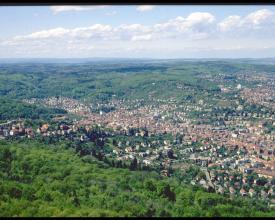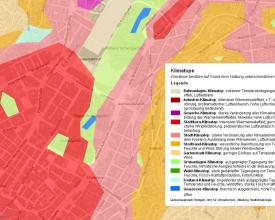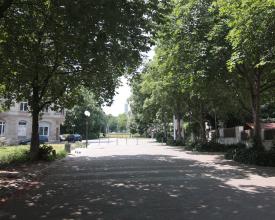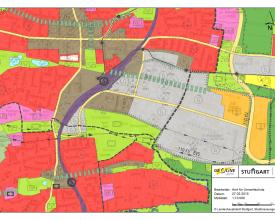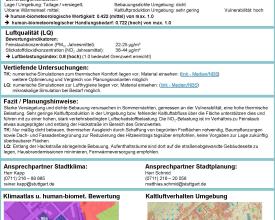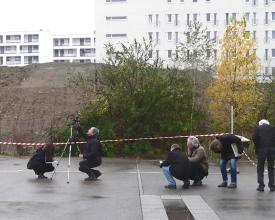
Green aeration corridors in Stuttgart City
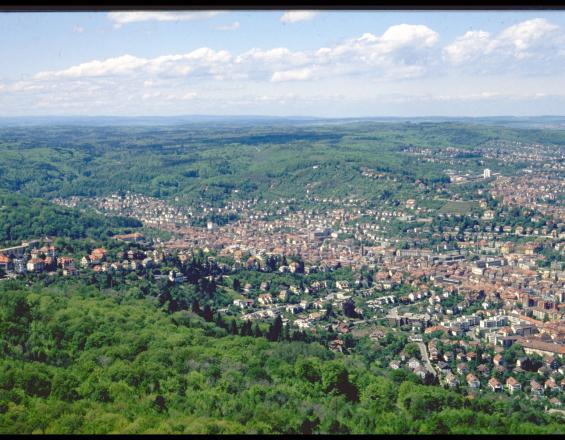
In Stuttgart, important green belts and green divides stretch between the built-up settlement areas, mitigating the climate heat stress. Greenery now covers more than 60% of the area. Furthermore, over 39% of Stuttgart’s surface area has been put under the protection of nature conservation orders. Incorporating these as important features in a Land Use Plan along with green belt policy are the most promising areas of municipal influence in respect of their impact on urban climatology and climate protection.
Context
Challenges addressed
The location of the city, its climate and the heat island effect contribute to poor air quality and to frequently human heat stress. Furthermore, heat stress from heat waves is likely to increase under climate change, impacting vulnerable people such as the elderly. The supply of fresh air and the reduction of heat stress must be prevailed against endeavours to provide additional housing and acquire building land.
Location
Process
Summary of the process
A climate Atlas for Stuttgart (building block 1) provides the basis for planning measures for the creation and protection of green spaces and corridors (building block 2), which are implemented through a Land Use Plan (building block 3). Add to this the "Klipps– Climate Planning Passport Stuttgart” (building block 4) , which is an evaluation tool to help identify areas and plan actions against heat stress suffered by people. Finally stakeholder participation and partnerships (building block 5) underlies the success of the scheme.
Building Blocks
Climate Atlas
The climate Atlas for the Stuttgart region was published in 2008 and comprises of standardised climatic assessments for 179 towns and municipalities in the Stuttgart region. It provides relevant information and maps required for urban climatic optimisation, such as regional wind patterns, air pollution concentrations, temperature, etc.
A key element of the atlas in terms of EbA planning for airflow and cooling is an area classification based on the role that different locations play in air exchange and cool airflow in the Stuttgart region. This is based on topography, development density and character, and provision of green space. The Atlas distinguishes eight categories of areas in this manner, and for each of them different planning measures and recommendations are provided.
Planning recommendations were included in the “Climate Booklet for Urban Development Online – Städtebauliche Klimafibel Online".
Enabling factors
The Atlas was based on the previous work in this area carried out by the City of Stuttgart since the 1980s and the in-house urban climatology department (in existence in the City of Stuttgart since 1938). Indeed a climate Atlas had been published in 1992, upon which the current Atlas was extended.
Lesson learned
Maps are important tools for planning and for communicating information to relevant stakeholders. They are necessary for attaining climatic and air quality goals.
The study provides important insights that can be used for climate protection and the recommendations include a focus on the transformation of green space and vegetation into the built city and the preservation and restoration of natural vegetation, including ensuring green corridors.
Green spaces and corridors
Topographic structures such as stream and meadow valleys provide natural green belts which at the same time represent preferred pathways for ventilation, while green spaces benefit urban climate and its protection:
- Vegetation exerts a significant stabilizing effect on the CO2 balance, cools the area and improves air quality.
- Green spaces serve as place-keepers, eliminating other uses which could impact negatively on climate protection due to potential emissions of relevance for the climate, such as roads or buildings.
- Where lower-level and less dense vegetation exists, green spaces promote ventilation within built-up areas through generation of cold air through thermally induced local wind systems such as ground wind and downslope winds and so act as fresh air corridors. This reduces exposure to pollutants and dissipates the build-up of heat and thermal stress, in particular during periods of extreme heat.
- Where vegetation is higher and denser, high wind speeds during storms are buffered. Furthermore, woodland plays a major role in terms of protection against soil erosion as a result of heavy rainfall and storms.
These green areas are protected and/or created in Stuttgart through the Land Use Plan.
Enabling factors
Climatic and air-hygiene maps represent an indispensable technical basis for green corridor planning.
Many legal aspects support the preservation and creation of green spaces and corridors, including nature protection regulations and the German Federal building law which was revised in 2004 and now require precautionary environmental protection in urban zoning and planning practices.
Lesson learned
Keeping natural green corridors free of encroachment by buildings does not necessitate a great deal of persuasion, given that aspects of landscape and nature conservation also support the urban climatology arguments. This joint argumentation featured predominantly in the debate surrounding conservation of the Greutterwald orchard district (Stuttgart-Weilimdorf).
Green corridors and networks are more important for climate objectives than small isolated green spaces, which have only a minimal remote impact in respect of their environment due to the so-called "oasis effect". However, this consideration does not in any way detract from the temperature-sinking importance of all vegetation areas.
Land Use Plan
A preparatory land use plan (PLUP) was undertaken, which organises land into its building and other types of uses and includes green areas and corridors. This PLUP is not legally binding, but serves as a basis for planning and information.
The land use plan developed in 2010 contains essential components for sustainable urban development, envisaging urban development under the slogan "urban─compact─green". Its guideline is for brownfield rather than greenfield development in a 4:1 ratio. It aims to protect green areas and develop a green network through brownfield areas.
Enabling factors
Constructive use of existing regulations (e.g. the German Federal Building Law) provides a mandate for the implementation of planning recommendations relating to local climate.
Furthermore, the city has had a climate change mitigation strategy since 1997 and a climate change adaptation strategy was developed in 2012.
Finally having an urban climatology section within the Office for Environmental Protection enabled creation of the necessary data.
Lesson learned
Having in-house climatic research capacity within a city municipality is rare but a huge advantage so as to provide concrete knoweldge and solutions, rather than applying general principals when creating a Land Use Plan that can address objectives of climate protection and air quality. Having detailed and concrete data for the city has allowed the engineering through planning and landscaping of an entire system for urban air circulation.
KLIPPS - Evaluation method for the human-biometeorological quality of urban areas facing summer heat
In addition to improving overall conditions related to increasing temperatures, the city of Stuttgart has designed an innovative project “KlippS – Climate Planning Passport Stuttgart” based on quantitative findings in urban human-biometeorology, for improving human thermal comfort. The KlippS project calculates the human thermal sensation under “warm” category during the daytime in summer. KlippS is divided into two phases: the first phase is concerned with a rapid evaluation of human heat stress for the areas involving “sustainable building land management Stuttgart”, the second focuses on numerical simulations at high-risk urban areas related to heat.
KlippS provides the following remarkable issues on a planning-related potential to mitigate local human heat stress:
a) innovative program involving the human-biometeorological concept which represents a new interdisciplinary field
b) various spatial scales including the both regional and local ranges on the basis of the systematical two-phase method
c) quantitative approach to human heat stress by using dominant meteorological variables such as air temperature T, mean radiant temperature MRT and thermophysiologically equivalent temperature PET
Enabling factors
As an ongoing project, the outputs of the KlippS project have been discussed in the internal meetings with the Department of Administration as well as the local council in the city of Stuttgart. On the basis of the meetings, the practical measures are provided for the implementation as soon as possible.
Lesson learned
People suffer heat stress through the combination of extreme hot weather on the regional scale and the inner urban complexity on the local scale. In principle, three options exist to mitigate the local impacts of severe heat on citizens:
a) heat warning systems of national weather service
b) adjustment of the individual behavior towards severe heat
c) application of heat-related planning measures
While both a) and b) work on the short term, option c) represents a long-term preventive way. In this perspective, KlippS was designed to develop, apply and validate measures, which contribute to a local reduction of severe heat.
The KlippS project was addressed at a lot of meetings and workshops, including at the public workshop “Climate change and Adaptation in Southwest Germany”, attended by 250 participants, on October 17, 2016 in Stuttgart. In addition to the workshops, KlippS was presented at many national and international scientific conferences.
Stakeholder participation and partnership
Partnerships and collaboration between different public bodies is necessary for the development and implementation of activities.
Furthermore, public participation is required for the development of a Land Use Plan and is also part of the implementation of green strategies aimed at improving air quality and buffering heat stress. For example, a scheme has been in place since 1992 for Stuttgart residents to adopt a tree, for which they are also responsible for.
Enabling factors
Having a mayor who supports green activities, relevant legislation and strategies, and in-house research facilities can help ensure cross-sectional collaboration.
Lesson learned
Partnerships between the City of Stuttgart and the Verband Region Stuttgart (the association of regional cities and municipalities) enabled the creation of the 2008 Climate Atlas.
Furthermore, thanks to close collaboration between the Office for Environmental Protection (analysis of information, provision of recommendations) and the City Planning and Renewal team, the recommended green infrastructure solutions are being implemented through spatial planning and development control.
Impacts
The urban climate, including air quality, is improved and heat stress is mitigated through green corridors and green spaces. Communities are thus more protected from the impacts of climate change, such as raising temperatures or precipitation changes. Furthermore, the green areas provide important recreational and well-being benefits. Finally, biodiversity is conserved through maintenance of green space and green corridors, which also contributes to carbon sequestration.
Beneficiaries
The inhabitants of Stuttgart City benefit in a twofold way: air quality is improved and heat stress is reduced. Also biodiversity benefits from the solution.
Sustainable Development Goals
Story
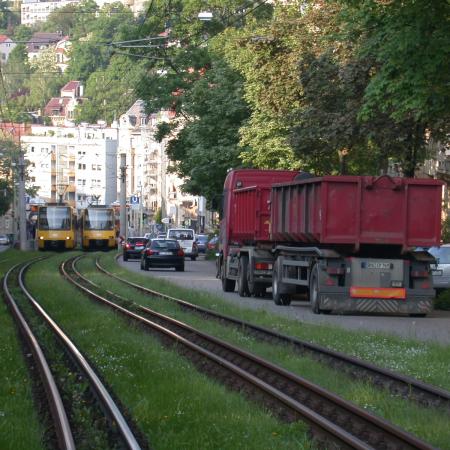
The municipality of Stuttgart has operated a Department for Urban Climatology within the Office for Environmental Protection since 1938, to take into account climate in urban planning and to make sure that the local climatic situation will not be deteriorated by planning.
Thermal stress and sensitivity to the effects of heat are common in combination with the mild climate of a wine-growing region. Stuttgart’s second handicap in respect to climate and air hygiene stems from its lack of wind, namely the episodic rise in air pollution.
Indeed the primary objective in terms of climate protection for the region of Stuttgart is to facilitate air exchange in the city, thereby enhancing the potential for cool air flows from the hills towards the urban areas on the valley floor. A land use plan, based on the recommendations from climatic studies, made provisions for green corridors and spaces to be protected and created. Precise recommendations for these green spaces to maximise air flow are included.
Green corridors and spaces that are well designed have been shown to ensure ventilation throughout the area, bringing numerous climate benefits such as cooling down the air temperature which buffers climate stress during heat waves and reducing air pollution, while also bringing many other benefits such as biodiversity conservation, carbon sequestration and recreational benefits.
Stuttgart is one of the rare cities in Germany to have over 39% of its surface area put under the protection of nature conservation orders. Other innovative green spaces have also been created within the built-up city, e.g. green roofs, facade greening and green rails (grass grown in between tramlines).
A short vision of the future could come true:
Imagine yourself wandering through the Stuttgart streets. It’s a really hot summer day, but you hardly have to sweat. Crowns of trees along the street provide shade. You use a small park as a thoroughfare, here it is more pleasant again. The air you breath is pure. The afternoon in your office is comfortable too, the building has a green roof and a green façade. Some bigger leaf-bearing trees save a direct sun radiation into your office, so you don’t need air conditioning. Later, you finish your work and enjoy the evening. Before you go to sleep you open the window in your bedroom. A cool breeze lets you fall asleep.
A deep sleep is very beneficial!
